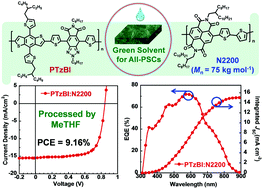Optimisation of processing solvent and molecular weight for the production of green-solvent-processed all-polymer solar cells with a power conversion efficiency over 9%†
Abstract
Increasing interest has been devoted to developing high-performance all-polymer solar cells (all-PSCs) owing to their specific advantages in light absorption and long-term stability. In this work, we systematically investigated the synergistic effects of processing solvents and molecular weight on the photovoltaic performance of all-PSCs, which consist of an n-type polymer N2200 and a p-type wide bandgap polymer PTzBI that are made up of benzodithiophene and imide-functionalized benzotriazole units. It is noted that increasing the molecular weight of N2200 can simultaneously enhance exciton generation and dissociation, reduce bimolecular recombination, and facilitate charge extraction. The films processed with the environmentally-friendly solvent 2-methyl-tetrahydrofuran (MeTHF) exhibit a more favourable film morphology than those processed with commonly used halogenated solvents. The all-PSC consisting of the high molecular weight N2200 and PTzBI processed with the environmentally friendly solvent MeTHF presents a remarkable power conversion efficiency of 9.16%, which is the highest value so far observed for all-PSCs. Of particular interest is that the PCE remains 6.37% with the active layer thickness of 230 nm. These observations imply the great promise of the developed all-PSCs for practical applications toward high-throughput roll-to-roll technology.



 Please wait while we load your content...
Please wait while we load your content...